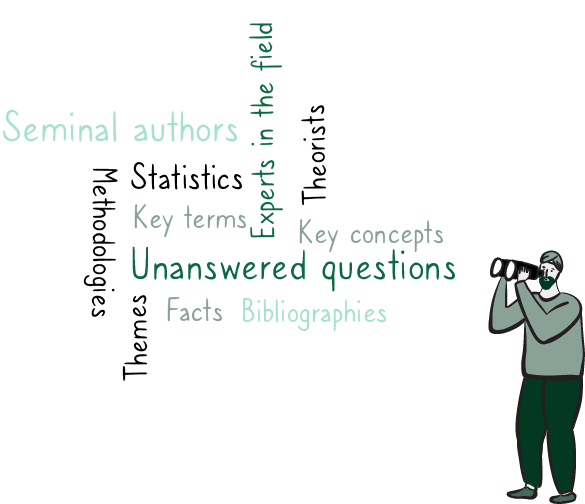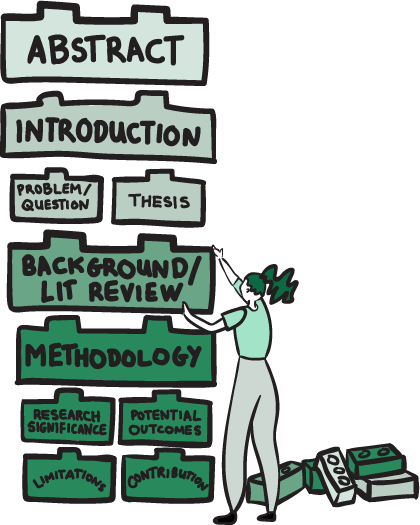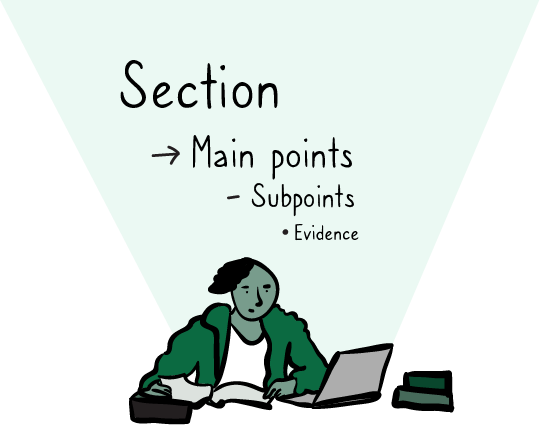What is a thesis proposal?

A thesis proposal is a map that outlines the relevant theoretical concepts, theories, and steps of your research project.
Within your proposal, you will communicate the problem being researched, your research questions, and how you plan to answer this question. Thus, your proposal is ultimately your research plan and should include:
- Background and review of relevant literature and theories
- Description of the research objectives, problem, purpose, and rationale
- Research question and potentially sub-research questions
- Methodological orientation, proposed methods, and plans for analysis
- Limitations and potential benefits of your research
A strong research proposal will demonstrate your ability to establish:
1. that you are capable of independent critical thinking and analysis
2. that you are capable of communicating your ideas clearly
Getting an overview of your topic

Before you start collecting books and articles, get an overview of your topic in encyclopedias, dictionaries, handbooks or atlases. These kinds of materials also help you to:
- Understand leading research themes and theories on your topic
- Identify experts, researchers and theorists
- Discover concepts and related vocabulary
- Identify potential research questions or ways to narrow your topic
- Locate facts, statistics and bibliographies (lists of related sources)
What is a seminal author?
Seminal authors, or works, refer to influential and core people or literature within a specific research area. You can identify seminal authors as they are often repeatedly cited across different works. It can be helpful when starting to explore a new body of literature to identify the seminal authors on that topic.
Research & reading resources
1. Plan your search strategy |
Choosing a Topic and Search Terms |
2. Evaluate your sources |
How to Evaluate Information Sources |
3. Tips for reading literature |
How to Read for Grad School
|
Developing Your Proposal

Below are common thesis proposal components across disciplines:
- Abstract: The outline or the summary of your work and research methodology.
- Introduction: An introduction that establishes the foundation for your proposal. This section puts your research and ideas in the correct context for the reader.
- Research Problem or Purpose - Explain the specific issue, problem, or gap that your research aims to address.
- Thesis statement - A concise statement that articulates the argument and positioning of your research.
- Background & Literature Review: All of your ideas will be supported by research and other well-known literature. This gives your work credibility and helps you avoid accusations of plagiarism.
- Methodology: In this section, you’ll include a brief overview of how you plan to approach the topic and the research method used for your work. This includes your methodological approach and methods.
- Research Significance: Describe what is particularly important about your proposed research.
- Potential outcomes: Explain what you expect to find through your research project.
- Limitations: Every study comes with its own unique limitations or constraints which impact the results. Outline these limitations, and explain how they could impact the findings in your research proposal.
- Contributions to knowledge: This is your opportunity to explain how your work will contribute to your field of study.
Here’s another resource for working on the different sections of your proposal:
The specific requirements of your proposal will vary by department. Make sure to review your department’s thesis proposal requirements to help guide your initial drafting. Ask your supervisor or graduate program administrators for information about what to include in your proposal.
Drafting Tips

Having trouble getting started? Here's a great way to get your ideas organized and plan out what to include in your proposal.
- Using the above framework, start by creating sections in your document for an introduction, literature review, and methodology section
- Within each section list out your main points.
- Under each main point list statements or evidence, you have to support your claim.
- Continue to develop any sub-points under their corresponding main points followed by statements and evidence.
- Repeat this process until you’ve exhausted all your ideas. Ensure you’ve addressed the sub-sections in our example outline.
- Following go back and begin to wordsmith and edit your proposal for clarity and flow.
Take a look at the links below for additional help!
Preparing for your proposal defence
The proposal defence is one of two defences (the other being the thesis/dissertation defence). The proposal defence practices vary by program. Ask your supervisor or graduate program administrators for information about your program's requirements.
The defence can be a very intimidating concept, but remember, often you are the expert in the room on your topic. Ultimately, your committee wants you to be successful, so do your best.
1. Watch your peers' proposal defences.
Some departments allow for public defences. If possible, we recommend students watch defences from your program to become familiar with your department's format. If your program doesn’t have public defence, you can always watch a proposal defence from a program similar to yours. However, be sure to remember that if the defence is from a different department, yours might go slightly differently.
2. Practice, practice, practice.
The best way to prepare is to practice your presentation. Make sure your presentation stays within the allotted time and that you feel comfortable with the material. You want to be able to present your topic so you feel natural in your delivery.
3. Think of example questions you might be asked.
A great way to prepare is to imagine potential questions you might be asked. Your committee wants to make sure your plan is intentional and purposeful. Familiarize yourself with your methods and theories, and think about why you choose them instead of others.
4. Hold a mock defence.
Hold a formal practice. If possible, try to hold your mock defence in the same room as the actual proposal defence. Invite fellow graduate students, friends, and family. This event will allow you to practice using the technology, delivering your presentation, and answering questions in a friendly, low-stakes environment.

